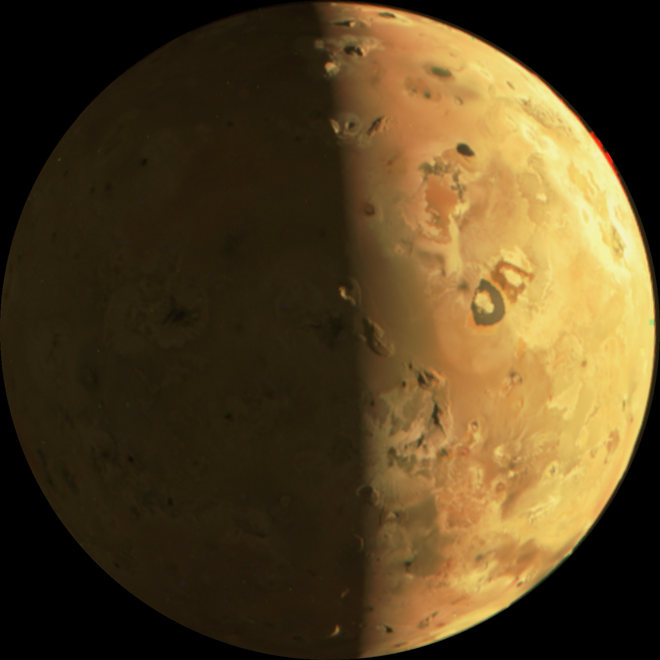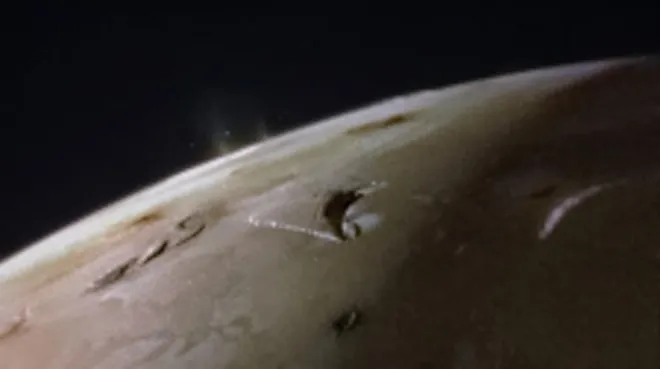NASA's Juno orbiter spots signs of volcanic eruptions on Jupiter moon of Io: Photos
The volcanic world of Jupiter's moon Io can be seen in extraordinary detail in new images beamed from NASA’s Juno orbiter after its most recent flyby.
The encounter was Juno's second with Io, pronounced EYE'-oh, after it first approached for a close-up view of the moon's rocky, fiery landscape on Dec. 30. Released on Sunday, the most recent shots from Juno show erupting plumes of volcanic activity, and tall mountain peaks with well-defined shadows and lava lakes, some of which may have their own islands, NASA said in a news release.
Scientists hope the images will help them discover more about this relatively mysterious world and what lurks beneath its surface.
“With our pair of close flybys in December and February, Juno will investigate the source of Io’s massive volcanic activity," Juno’s principal investigator, Scott Bolton of the Southwest Research Institute in San Antonio, Texas, said in a previous statement.
That includes "whether a magma ocean exists underneath its crust, and the importance of tidal forces from Jupiter, which are relentlessly squeezing this tortured moon," referring to how the planet's larger two moons perturb Io's orbit.

'Super Earth:'Could a nearby 'super Earth' have conditions to support life? Astronomers hope to find out
What is NASA's Juno spacecraft?
NASA’s Juno spacecraft has been probing beneath Jupiter's dense clouds since it arrived in 2016 seeking answers about the origin and evolution of the gigantic planet within our solar system.
That mission also extends to Jupiter's rings and many moons.
In December, Juno came within about 930 miles of Io's surface – equal the distance from New York City to Orlando, Florida. The craft's second ultra-close flyby of Io occurred Saturday, predominantly over the moon's southern hemisphere.
The flybys are the closest a craft has gotten to the surface of what NASA calls our solar system’s most volcanic world since the Galileo probe made numerous close flybys of Io in the 1990s and 2000s.
Mission scientists hope the visits will expose the source of Io’s massive volcanic activity, whether that's a magma ocean underneath its crust or the effects of tidal forces from the behemoth Jupiter pushing and pulling the moon, which is a bit larger than Earth's own moon.
NASA plans more observations of Io through 2025

Named for a mythological woman transformed into a cow during a marital dispute, Io is Jupiter's third-largest moon – and the most volcanically active world in our solar system.
Hundreds of volcanoes erupting lava fountains that spew dozens of miles into the air are active on the rocky moon, which was first discovered by the ancient astronomer Galileo in 1610.
Io's distance from Jupiter subjects it to tremendous tidal forces as it orbits the giant planet. As a result, the tidal forces generate heat within the moon, keeping its subsurface crust in liquid form and seeking any available escape route to the surface to relieve the pressure.
Molten lava is constantly filling in any impact craters and spreading new floodplains of liquid rock across the moon's surface, the composition of which remains a mystery to scientists.
But with luck, that limited understanding is about to change as scientists analyze the recent batch of images. And the mission will continue to conduct more distant observations through the remainder of its extended mission, which ends in late 2025.
“By combining data from this flyby with our previous observations, the Juno science team is studying how Io’s volcanoes vary,” Bolton said. “We are looking for how often they erupt, how bright and hot they are, how the shape of the lava flow changes, and how Io’s activity is connected to the flow of charged particles in Jupiter’s magnetosphere.”
Eric Lagatta covers breaking and trending news for USA TODAY. Reach him at elagatta@gannett.com

Disclaimer: The copyright of this article belongs to the original author. Reposting this article is solely for the purpose of information dissemination and does not constitute any investment advice. If there is any infringement, please contact us immediately. We will make corrections or deletions as necessary. Thank you.





